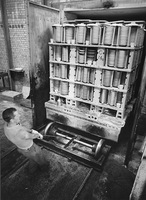 | Back to e-WV
| Back to e-WV
 The West Virginia Encyclopedia
The West Virginia Encyclopedia
 | Back to e-WV
| Back to e-WV
 The West Virginia Encyclopedia
The West Virginia Encyclopedia

In the 1920s, West Virginia was the third largest producer of pottery or chinaware. The Homer Laughlin China Company in Newell, Hancock County, and neighboring East Liverpool, Ohio, was by far the largest manufacturer.
Homer Laughlin and his brother, Shakespeare, arrived in East Liverpool following the Civil War. After an unsuccessful stoneware-making venture with Nathaniel Simms, they began to wholesale yellow ware and Rockingham ware, both crude, cheap types of tableware. Hoping to upgrade the local industry in 1873, the city of East Liverpool raised $5,000 for the Laughlins to start a pottery to make white ware, a finer product. Their Ohio Valley Pottery made ironstone china until 1877 when Shakespeare Laughlin left. In the 1890s, Homer added a line of semi vitreous porcelain, and in 1896 he incorporated as Homer Laughlin and Company. In 1898, he retired and moved to California.
W. E. Wells, Marcus Aaron, and other Pittsburgh investors took over the operation, retaining the Homer Laughlin name. They expanded at the turn of the century, built a second plant with 15 kilns and then a third. In 1903, they traded factories with the National China Company, ending up with three factories with 36 kilns. They expanded across the Ohio River into West Virginia beginning in 1902. On land purchased in Newell they built two more factories, and the town grew up around them. In 1914, they made semi-vitreous and white granite dinner, hotel, and toilet wares. In 1929, the Homer Laughlin China Company suspended operations in East Liverpool and concentrated in Newell, where they had five factories.
In the 1930s, Homer Laughlin China expanded its product lines, crowning the expansion with the famous Fiestaware, designed by Frederick Hurten Rhead in 1936. Fiesta shapes were streamlined with a semi reflecting surface. The stylish dishes were made in a brilliant orange-red and in complementary colors: a fairly deep blue, a green that fit precisely between the red and the blue, and the brightest yellow that would go with the red and the blue. Fiesta soon added a more subdued color, ivory vellum, and in mid-1937, a sixth color, turquoise. The original Fiesta was discontinued in 1973 and is now avidly collected.
The Homer Laughlin China Company revived Fiesta in 1986, which helped the company remain competitive in the tough home dinnerware market. Today, the Newell factory remains one of the largest potteries in the world. The company’s business peaked in the years following World War II, then suffered as imported dinnerware began to make deep inroads into the business of American manufacturers. To compensate for the loss of retail sales, Homer Laughlin began producing restaurant china in 1959.
In 2020, Steelite International acquired the company’s food-service divisions and brand names of Homer Laughlin China and Hall China. Homer Laughlin China maintained its retail division and renamed it The Fiesta Tableware Company, which solely manufactures home dinnerware. The company’s Newell location now serves as a retail-only tabletop and giftware manufacturer for Fiesta and other tableware.
Flip the plate the next time you eat out anywhere in the United States, and chances are you will see the Homer Laughlin fleur-de-lis or another of the company’s trademarks.
Written by James R. Mitchell
Cunningham, Jo. Homer Laughlin: A Giant Among Dishes 1873-1939. Atglen, PA: Schiffer Pub., 1998.
Page, Bob, Dale Frederiksen & Dean Six. Homer Laughlin: Decades of Dinnerware. Greensboro, NC: Page/Frederiksen Pub., 2003.
Gates, William C. & Dana E. Ormerod. "The East Liverpool, Ohio, Pottery District," in Ronald E. Michael, ed, Historical Archaeology. : (Mar., Oct. 1982).
Welch, Jack. The Homer Laughlin China Company. Goldenseal, Spring 1985.